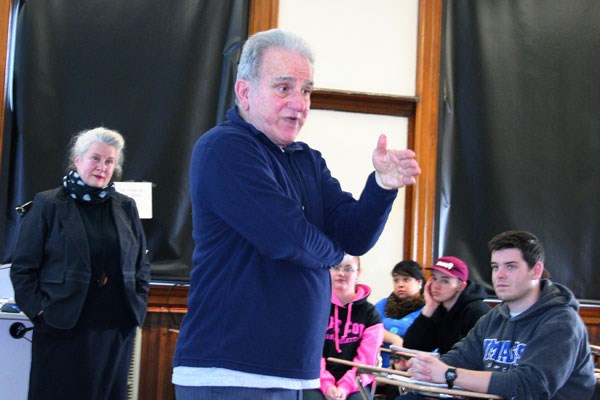Visiting Author Adds New Perspective to $500M in Missing Masterpieces

Author Stephen Kurkjian discusses the $500 million Gardner Museum heist with art history students and lecturer Jennifer Cadero-Gillette, left.
04/09/2015
By Ed Brennen
So their alibis check out.
But the students got a compelling look at the still-unsolved caper, along with a gripping lesson in the unseemly underworld of stolen artwork, when Pulitzer Prize-winning Boston Globe reporter and author Stephen Kurkjian visited class on April 2.
Kurkjian’s new book, “Master Thieves,” sheds light on the cast of big-time mobsters and small-time crooks he encountered while covering the Gardner heist for the Globe beginning in 1997. Kurkjian critiques the FBI’s dead-end leads and says the 25-year-old case can still be cracked if the general public “feels the loss” of the 13 stolen works, which were swiped by two men posing as police officers in the pre-dawn hours of March 18, 1990.
“Why is this a cold case? It’s ridiculous,” Kurkjian told the students. “It’s as if half a billion dollars were stolen from a Brinks truck. But it’s not. You know this. You’re studying this. This is something different. This artwork can evoke something, some creativity. And so it belongs to us.”
Cadero-Gillette’s class recently studied Baroque art, including Rembrandt’s “The Storm on the Sea of Galilee” and Vermeer’s “The Concert,” two of the pieces stolen from the Gardner. Kurkjian’s visit provided a modern-day, real-world connection to the centuries-old subject matter.
“I’ve been to the Gardner a few times and seen the empty frames, so I definitely can relate to this story,” said junior fine arts major Jarek Jesionowski, who added that the unsolved mystery gives the missing artwork “deeper meaning.”
“This is what I love about coming to these types of classes,” added sophomore economics major Jake Wisniewski, a self-professed history buff taking his second course in the Art Department. “It’s information you can’t just find randomly on the Internet, even if you wanted to. It’s real, personal stories told by people who have spent their lives working trying to figure this stuff out.”
Kurkjian, who retired from the Globe in 2007, explained how shoddy security made the Gardner vulnerable to theft, and how lesser-known stolen works are able to change hands unchecked in the cloistered world of art sales. “If you sell your Honda Civic with 250,000 miles to your brother, there’s a record,” said Kurkjian, who pointed out that no such formal record-keeping exists for art sales.
“This is a very different perspective for students to think about the loss of those paintings, and it’s a really inspiring tale for them, as well,” said Cadero-Gillette, who added that bringing in speakers like Kurkjian from varied backgrounds opens students’ eyes to career options they might not have considered before.
While the Gardner is offering a $5 million reward and the FBI has promised not to prosecute the perpetrators, Kurkjian said investigators would be better served having a high-profile member of the community like Matt Damon, Mark Wahlberg or David Ortiz make a public appeal for the artwork’s safe return.
“These are hard hearts. These are not people who are going to pick up the phone,” Kurkjian said of those who may hold the paintings today. “No one knows where this stuff is buried, but people know pieces of the story, and it’s those people who have to be convinced. This is a real loss to all of us, and we need to have it back because our grandchildren will miss it.”
“This is our patrimony. This is a part of our culture,” added Cadero-Gillette, who said she takes her classes to museums across the state each semester to connect them to that culture.
After hearing Kurkjian speak, sophomore history major Amanda Jennings said she was more inspired than ever to visit the Gardner for the first time.
“When he was talking about evoking emotion, I really got that sort of Boston feeling,” Jennings said. “This is something that we own. It’s a crime that hit us.”
Even if it was committed before they were born.
